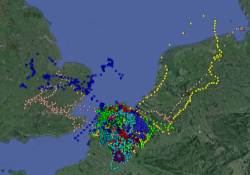The LifeWatch Gulls and Harriers: who are they, what do they do, and where are they going?
The bird GPS data from June 2013 to August 2016 reveals a lot of peculiar foraging behavior and interesting migration patterns. This is now disclosed in a renewed webpage.

In the framework of the Flemish contributions to the LifeWatch infrastructure, a high-tech sensor network was installed in June 2013 to better monitor the habitat use and migration patterns of large birds, such as the European Herring Gull (Larus argentatus Pontoppidan, 1736), the Lesser Black-backed Gull (Larus fuscus Linnaeus, 1758), and the Western Marsh Harrier (Circus aeruginosus (Linnaeus, 1758)). The birds are equipped with lightweight, solar powered GPS tags: currently 37 European Herring Gulls (Oostende), 108 Lesser Black-backed Gulls (Zeebrugge and Vlissingen), and 6 Western Marsh Harriers (Krekengebied) are tagged.
Since the establishment of this LifeWatch bird GPS tracking network, the GPS tags generated a lot of data, which revealed some very peculiar foraging behavior and interesting migration patterns. This was showcased in a first version of the “historical bird data” webpage, released in May 2014, where some individual stories were listed for the breeding season of 2013, the autumn migration of 2013-2014, and the spring migration of 2014. Now, a renewed version of the webpage is available, disclosing all GPS data from June 2013 to August 2016.
For each year, the data is divided into three time periods:
Click on the link below to find out:
Since the establishment of this LifeWatch bird GPS tracking network, the GPS tags generated a lot of data, which revealed some very peculiar foraging behavior and interesting migration patterns. This was showcased in a first version of the “historical bird data” webpage, released in May 2014, where some individual stories were listed for the breeding season of 2013, the autumn migration of 2013-2014, and the spring migration of 2014. Now, a renewed version of the webpage is available, disclosing all GPS data from June 2013 to August 2016.
For each year, the data is divided into three time periods:
- Spring migration (March-April)
- Breeding season (June-July)
- Autumn migration and winter season (August-February)
Click on the link below to find out:
- Who forages at sea, and who prefers the beach and fields?
- Who raids the chips factory in Moeskroen on a daily basis?
- What are the most popular foraging hotspots?
- What are they doing when they don’t have a nest?
- Where are they flying to during winter season and which routes do they take?
- Who is the most active, and who is a lazy bird?
- And many, many more!



